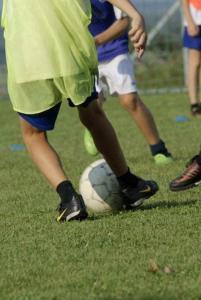High school athletes account for an estimated 2 million injuries per year. Nearly half of these sports injuries are overuse injuries in middle and high school students, many of which are linked directly with soccer enthusiasts. A study published from Massachusetts General Hospital in Boston found that more than 30 percent of emergency room visits were due to injuries in the lower extremities (i.e. legs, ankles, and feet). However, that study concluded many of the injuries didn’t require emergency care.
How will you know what steps to take when injury occurs? Whether your student athlete plays soccer, football, or is in marching band—here are some tips to help your family recognize and deal with a sprained ankle.
1. Understand the notorious ankle sprain is a common enemy in contact sports.
 Sprains are ligament injuries caused by excessive movement of a joint which “stretches out” those ligaments. These ligaments resemble the plastic that surrounds a six pack of soda (or your beverage of choice). Once they are stretched out, they will not fully return to their original shapes. We are left with an ankle that is less stable, especially in the direction that the sprain occurred.
Sprains are ligament injuries caused by excessive movement of a joint which “stretches out” those ligaments. These ligaments resemble the plastic that surrounds a six pack of soda (or your beverage of choice). Once they are stretched out, they will not fully return to their original shapes. We are left with an ankle that is less stable, especially in the direction that the sprain occurred.
Adding injury to insult (pun intended), the sprained ligaments lose the ability to efficiently communicate with your brain. This results in decreased coordination of the ankle. Try this—ask to watch someone with a recently sprained ankle attempt to balance on one leg: you will notice a general lack of balance and coordination that is reflective of this phenomenon.
2. Learn how ankle sprains occur to help prevent injuries.
Most ankle sprains occur to the ligaments along the outside of the ankle when the bottom of the foot rolls inward (inversion). Stepping on uneven ground or landing on another player’s foot are two common mechanisms for this type of injury.
3. Don’t, “play through the pain” if you do become injured.
When working with soccer players or any student athletes, many of them would gladly sacrifice the pain of a rolled or sprained ankle to play and help the team. It is often a challenge for younger athletes to let their body heal rather than try to push though the pain. I always ask, “Is 1 week of playing worth a lifetime of damage?” it’s all about perspective.
4. Call your Chiropractor to determine ankle sprain treatment.
First call your Chiropractor and describe your symptoms. Based on a few simple details, we can determine if an office visit is sufficient or if you need to have an X-ray to check for a fracture. This can help you avoid an unnecessary trip to the hospital which will save you time and money.
5. Learn what steps your Chiropractor will take if in-office care is needed.
Having your Chiropractor assess your ankles is truly a smart idea whether you’re elderly or an athlete of any caliber. Your Chiropractor will be able to assess the damage done, order imaging if needed, perform therapy to reduce the pain and swelling as well as rehab to expedite the recovery process.
I utilize 4 functional tests to determine whether an athlete is able to return to play. These tests grade range of motion, balance/proprioception, agility and strength. I always explain each test to my athletes and why they are being used. This allows the often overeager athlete and myself to have an understanding that when these tests can be performed properly, they are ready to play.
By creating a dialogue between your Chiropractor about you or your athlete’s symptoms, you will increase recovery time and decrease the long-term effects of the sprain. Schedule an appointment today if you need to discuss an ankle sprain, or read more here and here for additional training tips.

